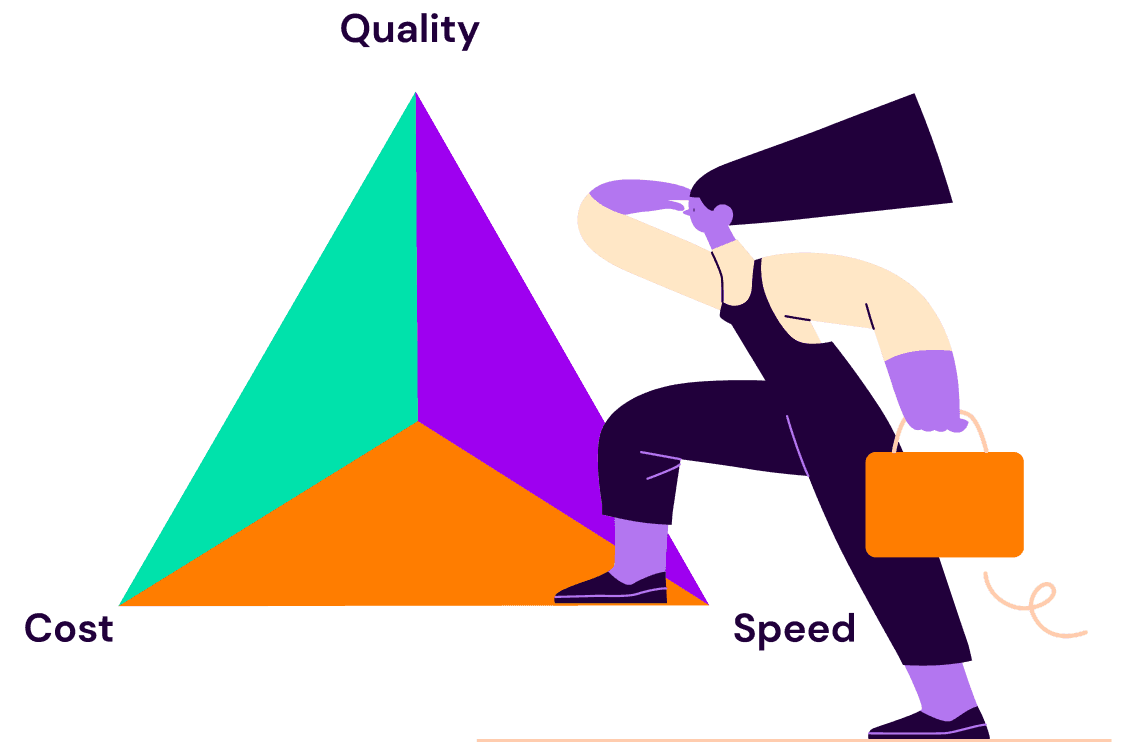
Back to blogs

How to Create an Ideal Candidate Profile that Aligns Your Hiring Team
When hiring gets stuck, it’s rarely because there’s a lack of candidates. More often, it’s because the hiring team isn’t aligned on what they’re looking for. One person is focused on technical skills, another on team fit, and someone else is prioritizing leadership experience. Without a clear target, every resume sparks a new debate, and the process drags.
An ideal candidate profile sets a concrete definition of success for a role. While job descriptions tend to list broad responsibilities and qualifications, an ideal candidate profile zeroes in on the skills, traits, and experience needed to thrive within your organization. It becomes the reference point for everyone involved in hiring and helps the team stay consistent.
But clarity doesn’t happen on its own. To build that shared understanding, you’ll need to work closely with your hiring manager, recruiters, and other stakeholders to gain a clear picture of what the role demands.
What is an ideal candidate profile?
An ideal candidate profile is a detailed, role-specific outline of the skills, traits, and experience someone needs to succeed in a given position. It goes beyond generic qualifications to focus on what truly matters in your environment.
Think of your ideal candidate profile as a blueprint for hiring. It highlights what a top performer looks like and what will drive impact on the team. That clarity helps every part of the hiring process move faster. It ensures recruiters know who to source, interviewers know what to evaluate, and hiring managers can make confident decisions based on aligned criteria.
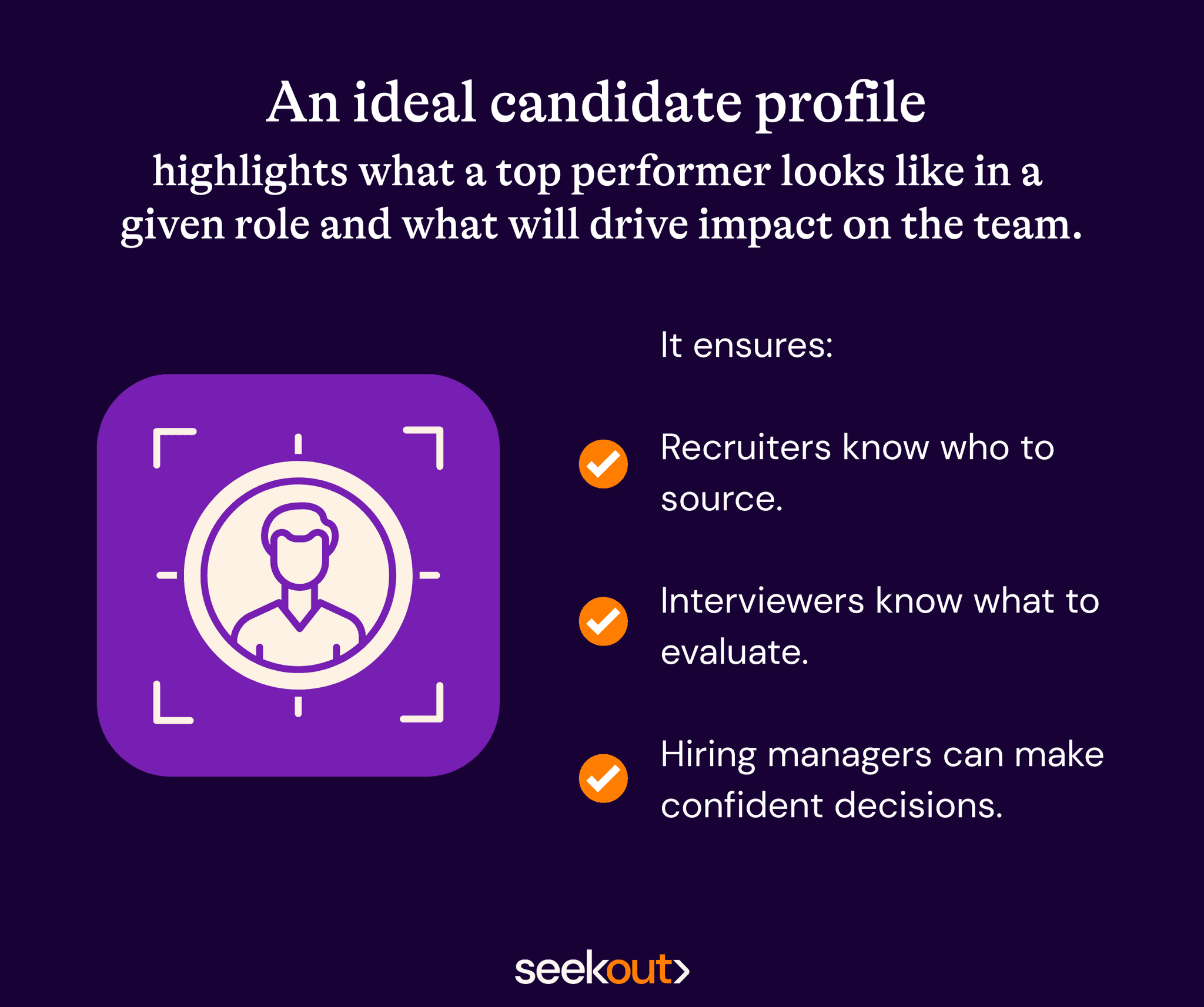
When done right, an ideal candidate profile also helps reduce bias. By anchoring the process in clearly defined, role-relevant requirements, your team can avoid leaning on instinct or shifting standards mid-search. It’s a practical way to keep hiring consistent, fair, and focused.
How an ideal candidate profile and a hiring rubric work together
An ideal candidate profile and a hiring rubric serve different purposes in your hiring strategy. While both bring structure and clarity to the process, they’re used at different stages to create a more consistent and equitable hiring funnel.
The ideal candidate profile is your starting point. It captures the big picture: what signifies success in the role, which traits matter most, and how to define a strong candidate within your team’s context. It’s collaborative, strategic, and built before sourcing begins.
A hiring rubric translates that profile into concrete, weighted criteria that guide how you evaluate candidates during sourcing, screening, or both. It breaks down must-haves, nice-to-haves, and bonus skills, and often includes a scoring system to help hiring teams focus and avoid bias during reviews.
Free hiring rubric template
DownloadPut simply:
The ideal candidate profile defines who you’re looking for.
The hiring rubric clarifies how to measure them.
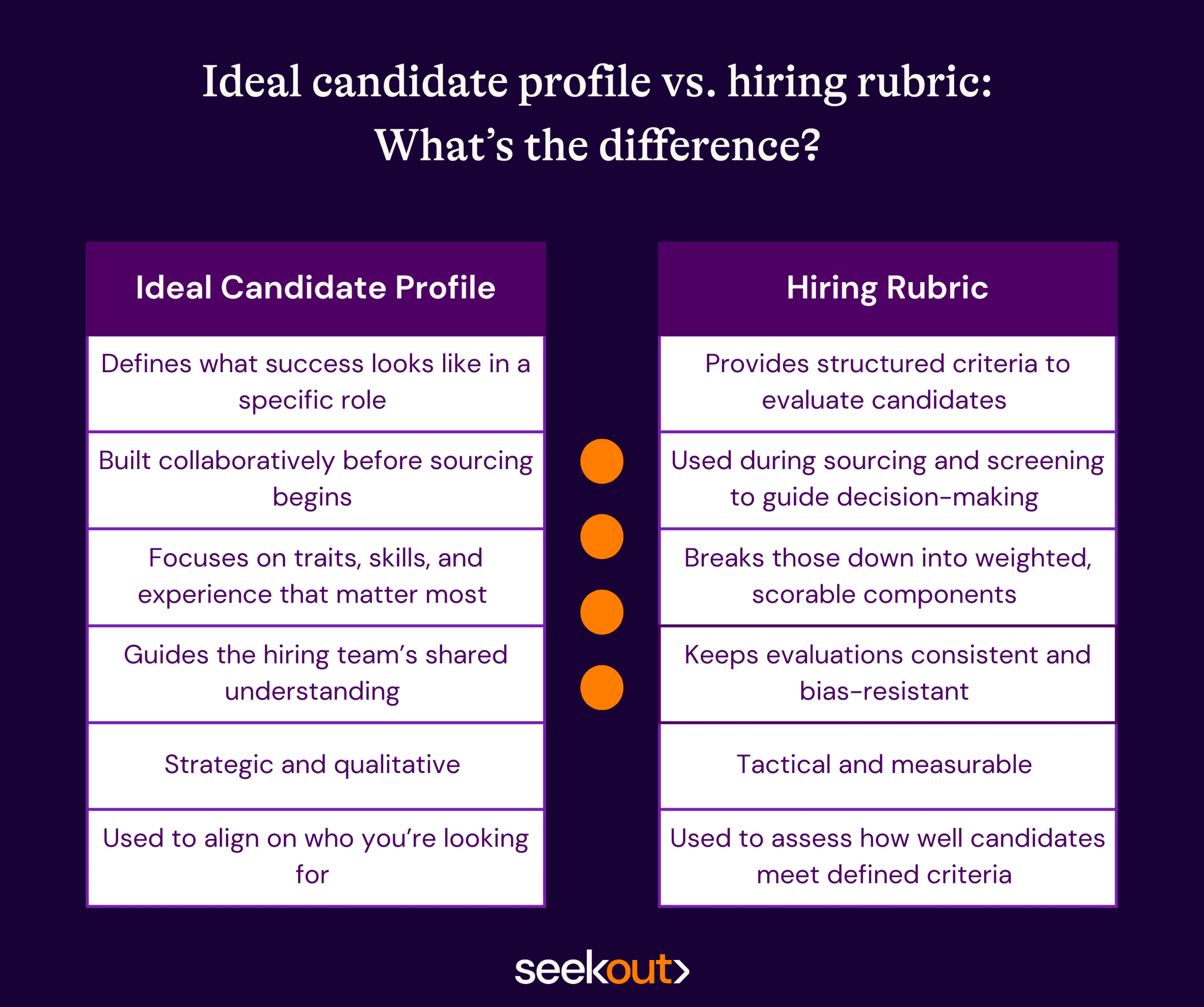
Used together, the ideal candidate profile and hiring rubric help your team avoid common pitfalls like inconsistent evaluations or gut-feeling decisions. This combination also sets the stage for better data. When your rubric is built from a clear, thoughtful profile, your hiring metrics become more meaningful.
What happens when you skip the ideal candidate profile?
Skipping the ideal candidate profile may feel like saving time up front, but it often slows everything down. Without a clear, shared definition of what you're looking for, hiring becomes reactive and inconsistent. Teams often run into issues like:
Vague requirements: Job descriptions list everything under the sun, but nothing specific enough to guide sourcing or screening.
Too many voices in the room: Without alignment, it’s hard to reach consensus on what a “strong” candidate truly is.
Shaky decisions: Without clear criteria, teams default to intuition, which invites bias and inconsistency.
When teams skip creating an ideal candidate profile, the hiring process often falls apart behind the scenes. Misalignment slows everything down, interviews become inconsistent, and hiring outcomes suffer. A strategic candidate profile helps you avoid all that by setting a clear, shared target from the beginning.
6 steps to build an ideal candidate profile
An ideal candidate profile sets the foundation before you start sourcing, so your team knows what you’re aiming for and why. Here’s how you can build one:
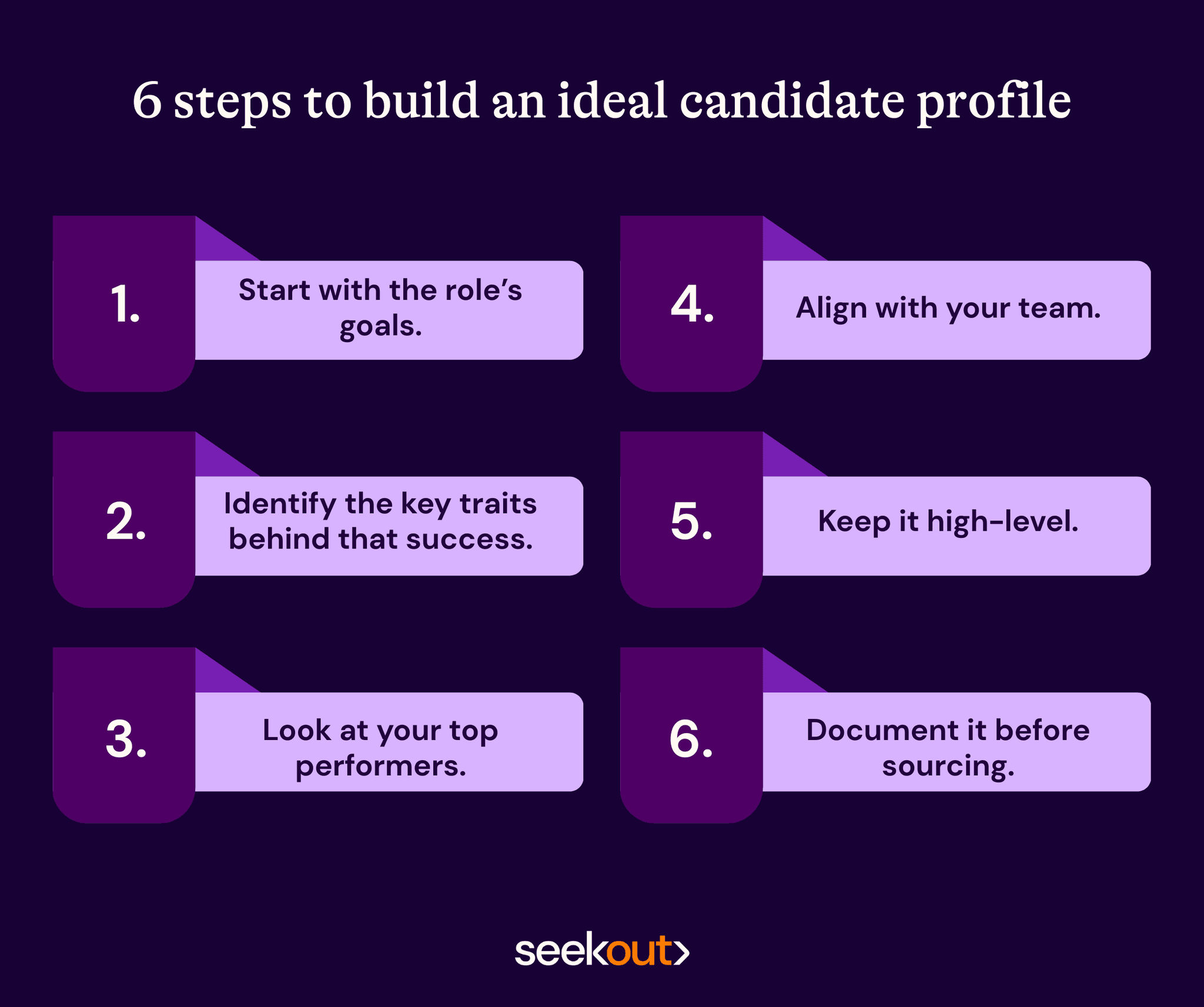
1. Start with the role’s goals.
Ask: What does success look like in this role? Define what the person should accomplish in their first 30, 60, and 90 days. For example, if you're hiring a customer experience manager, goals might include onboarding X number of accounts or improving response time by a specific percentage.
2. Identify the key traits behind that success.
Think about the characteristics—both skills and soft traits—that would help someone meet those goals. Is it adaptability? Strong communication? Deep technical expertise? Identify what matters most in your team’s environment.
3. Look at your top performers.
Who’s done this role well before? What made them thrive? Use that as a benchmark. If this is a new role, look for people in similar positions across your company or industry and consider what qualities they bring.
4. Align with your team.
Meet with the hiring manager, recruiter, and key stakeholders to build the profile together. Discuss what you’ve found and get consensus on what being a great candidate means. This avoids misalignment later.
5. Keep it high-level.
Don’t jump into listing must-haves or assigning scores yet—that comes later with your hiring rubric. For now, focus on defining the “who” at a strategic level. What kind of background, mindset, and working style will thrive in this role?
6. Document it before sourcing.
Write down your ideal candidate profile and share it with your hiring team. That way, everyone starts from the same understanding and can refer to it during sourcing, interviews, and decision-making.
A well-crafted candidate profile doesn’t need to be long, but it needs to be clear. When you take the time to define success upfront, the rest of the hiring process becomes smoother, faster, and more focused.
Bonus tip: Update your candidate profile as the role evolves
Even the best candidate profiles aren’t static. Once you start interviewing, you may realize certain skills are more critical than expected or that some nice-to-haves aren’t so nice after all.
That’s why it’s important to revisit your ideal candidate profile mid-search, especially if interviews aren’t yielding strong fits or the team starts disagreeing on who to move forward. Quick alignment meetings can help the team course-correct without starting over.
After hiring, use performance data and feedback to improve the profile for future roles. Over time, this transforms your ideal candidate profiles into a living library of insights tied to real outcomes.
Use SeekOut to turn your ideal candidate profile into hires
Once you've aligned on an ideal candidate profile, the next step is turning that alignment into action. SeekOut helps you do that across both Recruit and Spot.
Within SeekOut Recruit, our AI-powered recruiting platform, the Workspaces feature uses AI and your profile to create a shared, structured scorecard. It gives your team a consistent framework to evaluate every candidate. You can set weighted priorities, track how candidates align with desired criteria, and streamline feedback across reviewers.
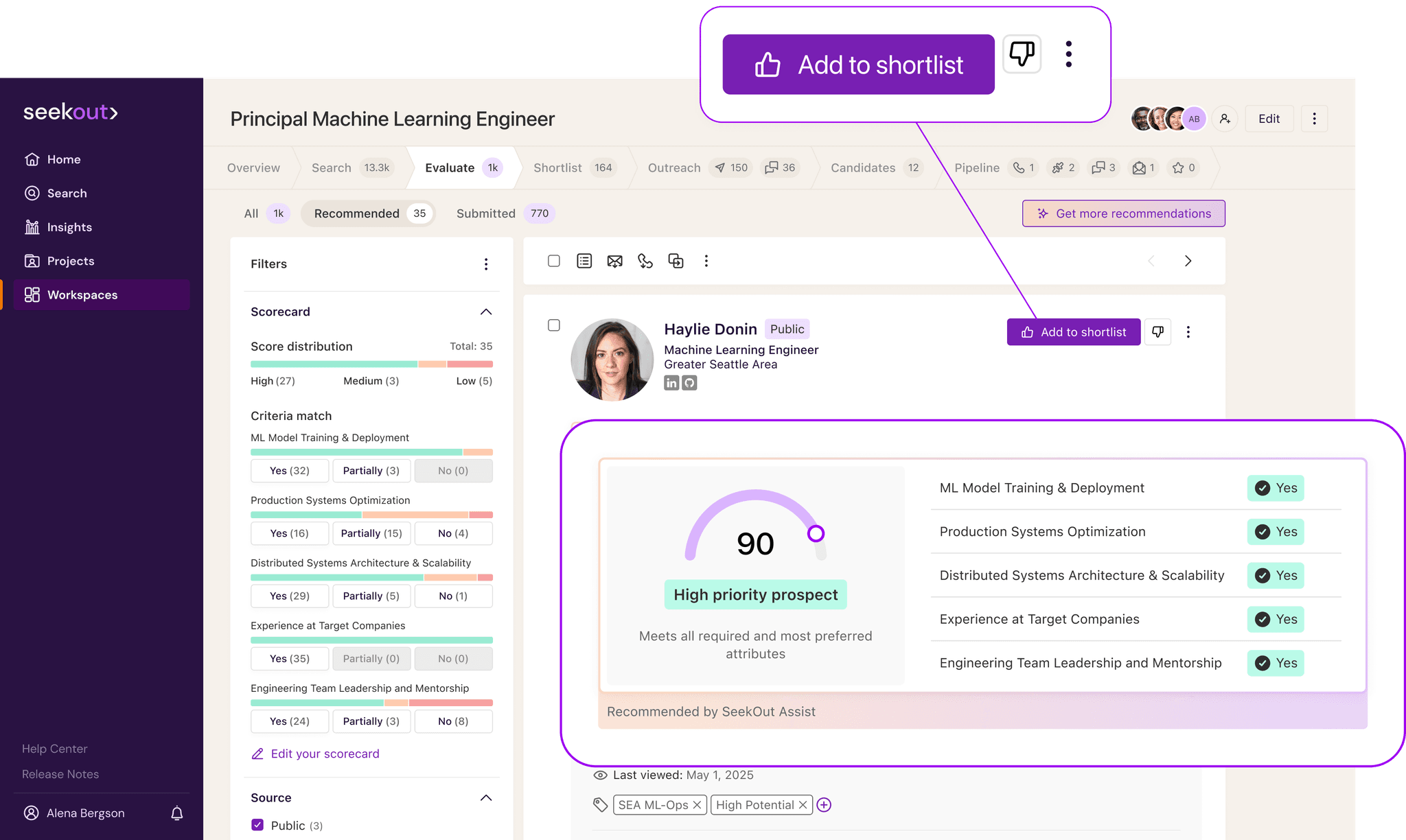
SeekOut Spot, our agentic AI recruiting service, tackles sourcing with the same level of precision, but without adding work to your plate. During a quick kickoff call, your team shares the ideal candidate profile. Spot’s agentic AI then translates it into a sourcing rubric and searches across millions of profiles to find top matches. Our expert human recruiters guide the process, so you can more time engaging right-fit candidates.
Set the stage for better hires
An ideal candidate profile is a tool that brings focus, structure, and alignment to every step of the hiring process. When your team agrees on what’s ideal for a role, you spend less time debating and more time making progress. From sourcing and screening to final decisions, a well-crafted profile helps you move quickly and reduce bias along the way.
And like any good strategy, it should evolve. Revisit your candidate profiles as roles shift, priorities change, or new data emerges. The more you refine and reuse them, the more effective your hiring process becomes.
Ready to find top talent? Use SeekOut Recruit to create a structured evaluation framework, or let SeekOut Spot source matches for you based on your criteria. Book a meeting to learn more.
Request a meeting
Book nowFrequently Asked Questions
What is an ideal candidate profile?
An ideal candidate profile is a clear outline of the skills, traits, and experience that define success in a specific role. Unlike a job description, which lists general qualifications, a candidate profile focuses on what truly matters within your team and culture. It gives recruiters, hiring managers, and interviewers a shared reference point to identify strong fits quickly.
Why is an ideal candidate profile important in hiring?
Without an ideal candidate profile, teams often disagree about what “qualified” means—leading to slow decisions and inconsistent evaluations. A defined profile aligns everyone early, helps recruiters target the right candidates, and ensures interviews measure against the same criteria.
How does an ideal candidate profile differ from a hiring rubric?
An ideal candidate profile defines who you’re looking for—your strategic vision of success. A hiring rubric defines how to evaluate that vision, breaking the profile into measurable, weighted criteria used during screening and interviews. Together, they make hiring more consistent and data-driven.
Who should be involved in creating an ideal candidate profile?
Hiring managers, recruiters, and key stakeholders should collaborate on the profile. Each brings different context: recruiters understand market realities, hiring managers know the role’s day-to-day impact, and leaders can align the profile with business goals.
What are the key steps to build an ideal candidate profile?
Start with the role’s goals, identify the traits tied to success, look at top performers, and meet as a team to align. Keep the profile strategic and concise, document it before sourcing, and revisit it as you learn more during interviews.
What happens if you skip the ideal candidate profile?
Skipping this step often leads to vague job descriptions, unrealistic expectations, and longer hiring cycles. Teams waste time debating candidates instead of evaluating them against shared standards, which increases bias and reduces hiring quality.
Should an ideal candidate profile change over time?
Yes. Roles evolve, priorities shift, and real-world performance data can reveal new insights. Revisiting and refining your profiles after each hire strengthens future searches and builds a knowledge base your team can reuse.
See us in action
Learn how SeekOut unifies people data to help organizations reach their talent goals
Request a demo